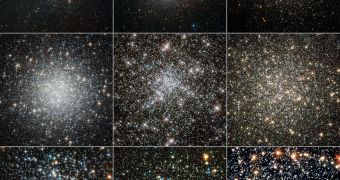A team of astronomers studied the ages of stars in globular clusters to determine the aging rate of various types of stars in different conditions. Some phenomena were understood, but astronomers wanted to come up with a model for aging which they could then apply to other places in the universe.
This isn't particularly surprising to astronomers anymore, but stars aren't always as old as they look. The analogy with humans is a bit strained, but people don't always look their age, in fact many look either older or younger than they really are.
That's the same with stars and the process through which this occurs, at least in some cases is understood. Globular clusters are some of the oldest structures in the Universe, they're a region densely packed with stars formed when the universe was very young.
The abundance of matter and the relatively small size of the universe meant that a lot of stars were formed close to one another, around the same time. Their gravity then kept them together.
These clusters formed billions of years ago, the ones in the study area at least 10.5 billion years old. In that time, most stars would have burned out or at least be dying by now. But that's not the case for many.
Because the stars are so close by, they feed off each other, and some stars, called blue stragglers, are as active and fit as they were billions of years ago by incorporating matter from other stars, either by syphoning it or from a collision.
They're called blue straggler because they're blue, indicating that they are both heavy and very bright, and because they lag behind the stars around them in the aging process.
The team focused on these blue stragglers and their position within 21 globular clusters in the Milky Way. They mapped the position of these stars in an attempt to determine how they aged, using Hubble to look at the center of the clusters and the ground-based MPG/ESO 2.2-metre telescope for the wider view.
What they found was a bit surprising. Normally, blue stragglers, being heavier than their surrounding stars, sink towards the core of the globular cluster, attracted by gravity.
In globular clusters that age quickly, these blue stars are all found towards the center, meaning no new ones are being formed in other parts of the cluster.
The team found a group, out of the 21 clusters they studied, that aged quickly and where all the blue stars were near the center. However, they also found that some of the clusters were still active with blue stragglers scattered all over the place. In yet another group, the stars had begun to gravitate towards the center, but were still widely distributed.
What this means is that these clusters, though formed around the same time, aged quite differently. In some cases, the blue stragglers were packed together in a few hundred million years, while in others the process will take several times the current age of the universe.
In the end, what it means is that more research is needed to determine what causes some clusters to burn out fast while others age a lot slower. The results of the study were published in today's issue of the Nature journal.

 14 DAY TRIAL //
14 DAY TRIAL //